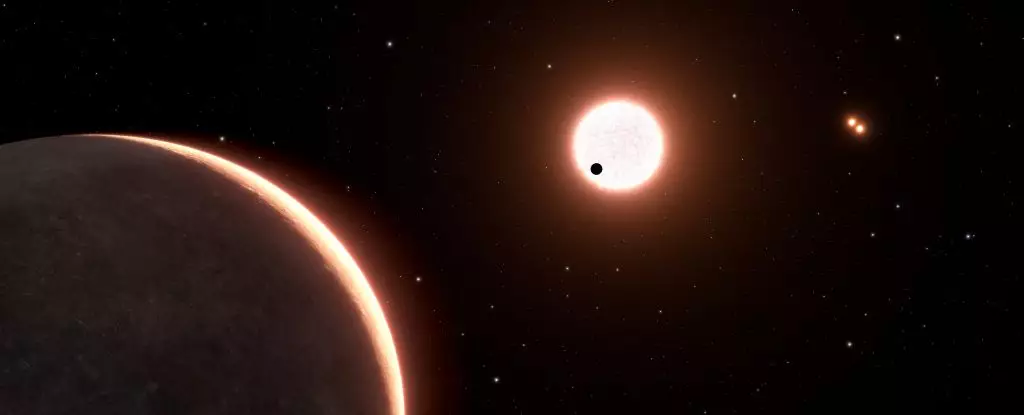Scientists in the US have recently confirmed the existence of an exoplanet called LTT 1445 Ac, located just 22 light-years away from our Solar System. This remarkable discovery marks the closest known Earth-sized world to us. While the exoplanet itself might be too hot to sustain life, its similarity to our own planet makes it a valuable object of study. By closely examining LTT 1445 Ac, scientists hope to gain insights into the evolution of planets and the factors that differentiate one Earth-like world from another.
LTT 1445 Ac was initially detected using data from the TESS (Transiting Exoplanet Survey Satellite) in 2021. However, due to observational challenges, astronomers could not be certain about its properties. One of the complexities in studying LTT 1445 Ac is its location within an unusual trinary system. The exoplanet orbits one of three stars that are gravitationally bound to each other. This arrangement poses challenges in observing the exoplanet accurately since the stellar companions also impact the light emitted by the star.
Unveiling the Properties of LTT 1445 Ac
To understand the characteristics of an exoplanet, scientists rely on two types of measurements: transit data and radial velocity data. Transit data captures the small dips in starlight that occur when an exoplanet passes between its host star and observers on Earth. On the other hand, radial velocity data records changes in the wavelength of starlight as the exoplanet’s gravity subtly pulls on the star, causing it to wobble. These measurements enable scientists to determine the radius, mass, and density of the exoplanet.
The transit data provides insights into the radius of LTT 1445 Ac by measuring the amount of dimming during a transit. The radial velocity data, on the other hand, allows scientists to estimate the exoplanet’s mass. By combining these values, researchers can ascertain the density of the exoplanet, which unveils its composition. A low density suggests an exoplanet with a significant atmosphere, resembling a gas giant. Conversely, a higher density implies a rocky composition akin to Earth, Venus, Mars, or Mercury.
While TESS primarily uses the transit method, the resolution of the TESS data on LTT 1445 Ac was insufficient to determine if the dimming was caused by the entire planet or just a portion of it ‘grazing’ the star. To acquire a better understanding of this world, higher resolution transit data was crucial. This is where the invaluable contribution of the Hubble Space Telescope comes into play.
Using the Hubble’s Wide Field Camera 3, a team led by astrophysicist Emily Pass of the Harvard & Smithsonian Center for Astrophysics conducted observations of the LTT 1445 system. Their objective was to search for transits of LTT 1445 Ac. Due to the gravitational interactions between the stellar companions and the resulting dips in starlight, the TESS data had some uncertainties. However, by observing the exoplanet crossing in front of the star, the team managed to obtain a high-resolution measurement of LTT 1445 Ac’s diameter.
With the radius and mass measurements in hand, researchers successfully determined that LTT 1445 Ac has a density of 5.9 grams per cubic centimeter. Comparatively, Earth has a density of 5.51 grams per cubic centimeter. This suggests that LTT 1445 Ac is likely a rocky exoplanet of a similar size and composition to our own. Nonetheless, the hostile conditions surrounding the exoplanet make it unlikely to support life as we know it.
The host star of LTT 1445 Ac is a red dwarf, characterized by its cooler and dimmer nature compared to our Sun. Despite this, the exoplanet’s orbital period is merely 3.12 days, resulting in an average temperature of around 260 degrees Celsius (500 degrees Fahrenheit). While not habitable, the ability to acquire clear transit data opens possibilities for studying LTT 1445 Ac’s atmosphere. Further characterization of this exoplanet offers valuable insights into the formation and evolution of Earth-like worlds in various system architectures. Understanding these factors can ultimately aid scientists in assessing the likelihood of life emerging elsewhere in our galaxy.
LTT 1445 Ac, the closest known Earth-sized exoplanet to our Solar System, provides scientists with a unique opportunity to explore and understand the characteristics and evolution of planets similar to our own. By employing transit and radial velocity data, researchers have gained insights into LTT 1445 Ac’s radius, mass, and density. Although uninhabitable, studying this rocky exoplanet can unlock valuable information that greatly contributes to our knowledge of exoplanets and the potential for life beyond our planet. As technologies like the Hubble Space Telescope and the upcoming James Webb Space Telescope advance, our ability to study exoplanets and their atmospheres will continue to deepen, paving the way for exciting discoveries in the field of astrobiology.


Leave a Reply